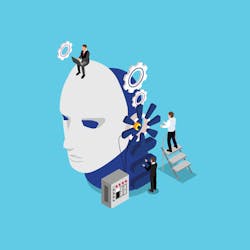Smart systems usher in a new era of proactive physical security
In the ever-evolving landscape of security, a silent revolution is underway. Artificial intelligence (AI) and machine learning (ML) are no longer just buzzwords; they're reshaping the very fabric of how we protect our spaces, assets, and people. These smart systems are not just observing – they're thinking, predicting and enabling security professionals to do more with less.
Imagine a world where security cameras don't just record but understand. Where access control systems don't just grant or deny but anticipate. This isn't science fiction – it's the new reality of AI- and ML-driven security technologies. But what exactly can these smart systems do? And perhaps more importantly, what can't they do?
The Power of Perception
At its core, AI in security is about enhanced perception. Traditional systems see; AI-powered systems comprehend. They can distinguish between a curious customer and a potential shoplifter, recognize when a patient in a hospital might be at risk of falling, or identify unusual traffic patterns that could signal an impending incident.
These systems are like having an army of tireless, ever-vigilant observers. They don't get distracted or tired and can process vast amounts of information in real time. But here's the kicker—they're not replacing human security personnel. Instead, they augment them, allowing security teams to focus on what humans do best: making nuanced decisions and responding with empathy and understanding.
Proactive, Not Just Reactive
One of the most exciting aspects of AI and ML in security is their ability to shift the paradigm from reactive to proactive. These systems don't just wait for incidents; they actively work to prevent them.
Consider a smart video management system in a retail environment. It's not just watching for shoplifters; it's analyzing customer flow, identifying bottlenecks, and helping store managers optimize layouts for security and sales. AI can monitor patient rooms in a healthcare setting, alerting staff to potential fall risks or unusual behavior patterns that might indicate a health issue.
But let's be clear – these systems aren't crystal balls. They can't predict the future with certainty, but they can identify patterns and anomalies humans might miss, giving security teams a crucial head start in addressing potential issues.
Doing More with Less
In an era of tight budgets and high expectations, AI and ML are game changers. They allow security departments to extend their reach and effectiveness without necessarily expanding their workforce. Here's how smart systems are helping security teams punch above their weight:
- Automated Monitoring: AI can continuously monitor multiple video feeds from one to dozens or many hundreds of cameras, flagging only the events that require human attention.
- Intelligent Dispatching: ML algorithms can analyze incidents, learn from the patterns, and automatically dispatch the most appropriate response.
- Predictive Maintenance: AI can monitor the health of security equipment, predicting failures before they occur, helping reduce downtime.
These capabilities don't just save time; they fundamentally change how security teams operate, allowing them to be more strategic and proactive in their approach.
The Integrator's Advantage
For security system integrators, the rise of AI and ML presents both a challenge and an opportunity. The challenge lies in staying ahead of the curve, understanding these new technologies, and being able to implement them effectively. The opportunity, however, is immense.
Integrators who successfully navigate this new landscape can offer their clients security systems and comprehensive, intelligent solutions that provide tangible business value. They're no longer just installing cameras and access control points; they're implementing systems that can provide actionable business intelligence, improve operational efficiency, and enhance overall safety.
Moreover, these smart systems often require ongoing support and updates, creating opportunities for long-term service contracts and deeper client relationships. The key is to position oneself as a security provider and a strategic partner in leveraging technology for business success.
Beyond the Hype: What AI Can't Do
While AI and ML's potential for security is enormous, it's crucial to understand their limitations. No matter how advanced, these systems are tools—not magic wands.
AI can process vast amounts of data and identify patterns, but it can't understand context the way humans can. It can flag unusual behavior, but it can't always understand the nuanced reasons behind it. Most importantly, AI can't make ethical judgments or handle complex, unpredictable human interactions.
That's why the human element remains critical. The most effective security strategies combine AI's tireless vigilance and processing power with human operators' judgment, empathy, and adaptability.
Integrated Intelligence
The true power of AI and ML in security lies not in individual smart devices but in integrated systems. When video surveillance, access control, perimeter security, and various edge devices like multi-sensors and audio detection systems work together, sharing data and insights, the result is a security ecosystem greater than the sum of its parts.
This might mean a system that correlates access control data with video analytics and environmental sensors to create a comprehensive picture of building usage and security status in smart buildings. In education settings, it could involve systems integrating video with audio analytics to detect and respond to potential safety threats more quickly and accurately.
The key is interoperability – the ability of different systems and devices to communicate and work together seamlessly. This is where open platform solutions shine, allowing for integrating best-of-breed technologies to create truly customized and effective security solutions.
The Road Ahead
As we look to the future, the potential applications of AI and ML in security seem boundless. From facial recognition systems that can identify persons of interest to predictive analytics that can forecast and prevent security incidents before they occur, the possibilities are both exciting and, to some, daunting.
But as we embrace these new technologies, we must also grapple with important questions about privacy, data security, and the ethical use of AI. The challenge for the security industry will be to harness the power of these technologies while ensuring they're used responsibly and in ways that respect individual rights and societal values.
For security professionals, integrators, and end-users alike, the message is clear: the future of security is intelligent, integrated, and proactive. Understanding and embracing AI and ML technologies can create safer, more efficient spaces that protect and enhance our daily lives.
The smart security revolution is now. Are you in?
About the Author

Howard Carder
freelance writer specializing in the physical security and professional audio/video industries
Howard Carder is a seasoned freelance writer specializing in the physical security and professional audio/video industries. With over 30 years of experience, including a long tenure at a large, global video security company, Howard has crafted compelling content for leading brands and publications across the industry. His expertise spans video security and Pro AV technologies, allowing him to distill complex topics into engaging narratives. Howard's work includes hundreds of case studies, white papers, and thought leadership articles. When not writing, he enjoys playing music and exploring healthy cooking. Learn more at www.hcwriter.com.

